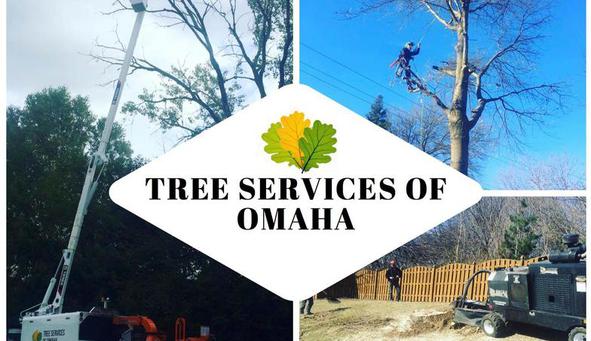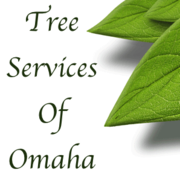Tree Services of Omaha - Omaha, Nebraska
Hazardous Trees - Prevention & Treatments
by David Steg on 10/01/14
What is a Hazard Tree?
A tree failure occurs when a tree or large part of a
tree breaks and falls. Hazard Tree Management deals in probabilities of failure rather than certainties. Age, species (especially rooting and branching characteristics), site, and condition all influence the relative hazard of the tree. A high probability of failure does not make a tree a hazard; there also must be a “target” that could be damaged or injured if the tree fails.
Trees become a potential hazard when there is a target. A target is a structure, vehicle or a person that would be struck by a falling tree or its parts. The target directly influences the degree of hazard. Consider the differences among a tree falling on a fence, a house or a person. A tree leaning over the bedroom is most hazardous. Trees near high- use areas are more of a risk than those near infrequently visited areas, as the probability of a person being hit is greater. Priorities for removal or corrective treatments depend on the hazard rating of the tree.
Tree age is important in hazard tree management. Every tree species has an inherent life span. Some trees in- herently live longer than others. Risk of failure increases with age. Longevity should be considered when evaluating existing tree hazards or selecting species to plant. Generally, longer-lived species are preferred, un- less plans are made to maintain or periodically replace less persistent species.
The environment in which a tree lives will also de- termine its hazard potential. Trees growing on rock ledges or near a body of water often have shallow root systems. Trees recently exposed by the removal of neighboring trees are more susceptible to damaging winds.
Observe the Trunk
Decay, a major cause of tree failure, is caused by fungi that weaken wood as they grow and reproduce. As healthy trees bend and sway, wood fibers slide past each other. Decaying tissues, however, are not flexible and often break. Each species of fungi has a characteristic, often con- spicuous, reproductive structure. Some are conks, which are woody and perennial, while others are mushrooms that are soft and deteriorate after a short (e.g. several days to a few weeks) period. The presence of many reproductive struc- tures often indicates advanced stages of decay.
Decay is often present without obvious signs. Cracks, seams, butt swell, dead branch stubs and large, older wounds suggest internal decay. Decay fungi typically need an opening in the tree’s bark to enter the tree. Openings in the bark above and below ground are caused in a variety of ways. Fire, lightning, branches rubbing each other in response to wind and the activities of insects, humans, birds and other animals can wound a tree. Wounds and cankers are two types of tree defects associated with hazards. Cankers are usually tree diseases that are perennial and aggressive. These defects enlarge with time and increase the likelihood of tree failure.
Wounds and cankers can be weak points on a trunk and their position relative to the prevailing winds influences the risk they represent. A tree is more likely to break at a wound or canker if it is facing or opposite to the direction of the prevailing wind. Most trees fail during winds greater than 40 mph. Some fall on a perfectly still day. Vertical cracks or seams along the trunk suggest internal defects.
A hollow tree is not necessarily a hazard tree. Cavi- ties develop from bark wounds. Many old trees have large conspicuous cavities or “hollows” in the main trunk, large root or branch. Vigorous trees have been observed to grow more sound wood around the hollow, compensating for that lost to decay. Compartmentalization of the decay also pre- vents the size of the “rotten compartment” from expanding. In later years, this new wood is continuous with the spread- ing roots and the tree can be strong enough to exist safely for many more years.
Inspect the Crown
Crown vigor and form are two indicators of the general health of trees. Crown characteristics of a potential hazard tree include dieback, V-shaped forks and lopsided- ness. Branches in the upper crown often die from the top down in response to stress. Repeated insect defoliation, ex- tended periods of drought, soil compaction or root disease cause stress. Opportunistic pests, such as insects and fungi, often invade and further stress the tree.
Trees can recover from dieback, if the source of the stress is eliminated in time. However, trees with advanced crown decline will die and should be removed.
V-shaped forks are weak compared to broader angled forks and branches. Ice storms, heavy wet snow or high winds often trigger failure. Elm, oak, maple, yellow- poplar and willow are especially prone to break at weak forks. Corrective pruning when trees are young can prevent many of these problems.
Trees that grow on the edge of a woodlot or trees crowded together often form lopsided crowns or lean into
Binoculars are helpful. Walk completely around the tree. Documentation is recommended, especially where you are responsible for a large number of guests. Documenta- tion is also helpful to track tree health.
A word about your liability. If you have a hazard tree, you may be responsible for any damage it causes if it falls. If a tree in your yard fails and damages your neighbor’s property, and you have no prior knowledge of its condition as a hazard tree, your neighbor’s general policy may cover the damages. This determination however, may be disputed. Documenting the condition of your trees can be important in case of litigation involving the failure of a tree.
Treatments
Since all trees are potential hazards, the only way to completely eliminate a tree hazard is to remove the tree. Where this is not acceptable, regular inspection and appro- priate action is the best way to “have your trees and reduce your risks.”
Dead trees within the range of a target should be removed. A common question is “How long does it take a standing tree to fall after it dies?” The small twigs and branches typically fall first, followed by larger branches and ultimately the trunk. This process can take several years. Trees that die and have limited hazard potential can be left as “snags” for wildlife.
When removing a hazard tree, prevent creating another hazard tree by limiting damage to the site and re- sidual trees. Opening the area potentially exposes the re- maining trees to additional sunlight, wind and ice loading.
Pruning, cabling and bracing are remedies for re- ducing hazards and keeping a tree in the landscape. These generally require special tools, equipment and expertise, but certain trees are worth the investment. Prune dead, broken or hazardous branches correctly. Weak branches or V-shaped forks can be supported with wire cabling or braced with metal rods. Appropriate treatments vary in cost and required expertise.
Prevention
Prevention is the best action. Start a tree health program as soon as possible. Proper selection and place- ment of trees prevents many hazard problems. Hazards are often created when a tree is bought and planted, regardless of the original intention. Care of trees during construction projects is also very important in avoiding tree hazards.
Caution: Hazard trees are unpredictable. They do not always fall when and where you think. Don’t try to solve one problem just to create another. When in doubt contact your county Extension agent or favorite tree professional.



